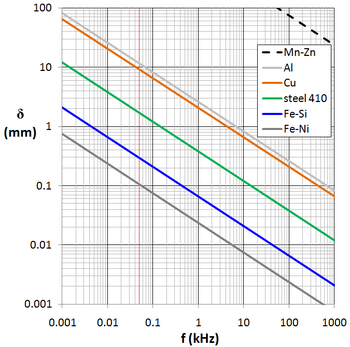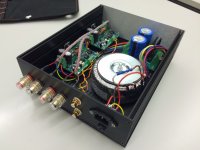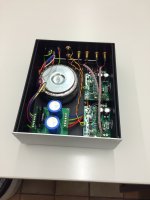Mouser is nice people. I received the following from their sales team:
~Tom
We are going to refund the shipping charges on the second order that needed to be placed for the missing pieces on following invoices.
37338055
37404730
~Tom
As you decrease power, the THD+N increases. Is the increase all due to noise, or does distortion increase also?
The noise floor limits the THD+N at low output powers. The harmonic spectrum doesn't appear to change much as you can see in the FFT measurement at 1 W.
An externally hosted image should be here but it was not working when we last tested it.
I am about to fit my two Mod-86 boards, power supply and transformer in my chassis and I was wondering what the best layout is.
Keep the wiring to the transformer as short as possible and keep the primary wires and secondary wires tightly coupled. You don't need to twist them together, but at least wire tie them tightly to minimize the loop area. This will minimize the inductive coupling from those wires. Keep the transformer and its wires away from the inputs of the amp if possible.
The Modulus-86 is rather immune to mains hum. Even in my lab setup with a rats nest point-to-point power supply, the largest mains hum residual measures -120 dBV. I wouldn't lose sleep over the chassis layout, as long as you follow the guidelines above.
~Tom
Mouser is nice people. I received the following from their sales team:
~Tom
Yes, as mentioned before Mouser did not charge for the 2nd order I had to make owing to the issues with their database losing items on a multi project order.
Lucia was very courteous and helpful. According to their invoice it cost them $25 dollars to ship to UK. That said they put it in a box when it could have gone in a medium size envelope.
Boards are fully populated now. Got to test the system and squeeze it all into the case some time this week I hope. Then find out how Dad takes to the transition back to solid state.
Yes, as mentioned before Mouser did not charge for the 2nd order I had to make owing to the issues with their database losing items on a multi project order.
The few people who were bit by this bug and have not had their invoices adjusted automatically, please contact sales@mouser directly. Mouser is aware of the bug. Just let them know that you ordered two projects but received the incorrect quantity of some parts. Attach your invoices.
Orders placed within the past week and going forward should all be correct. Should...
Boards are fully populated now. Got to test the system and squeeze it all into the case some time this week I hope.
Yay...
~Tom
It is born...
Nice that looks really slick. Question - how did you terminate the wiring onto the binding posts? Thanks 🙂
Nice that looks really slick. Question - how did you terminate the wiring onto the binding posts? Thanks 🙂
Looks like a solder + heat shrink job to me...
Nice build!
~Tom
Mouser is nice people. I received the following from their sales team:
~Tom
Indeed they are. I received a refund for shipping for the second order from them. Well done, Mouser.
Nice that looks really slick. Question - how did you terminate the wiring onto the binding posts? Thanks 🙂
Thanks! Yes, solder + heat shrink. Don't know if that's the best way, but it seems solid and looks quite nice. This is my first DIY project so I'm learning as I go.
Last edited:
Nice job 😎...but is this case heatsink enough?
Thanks! That remains to be seen😕 The sides of the case are not just flat but sort of pseudo heat sinks with some horizontal fins.
I suggest to move the small signal input cables, slightly farther away from the transformer.
Good point. The wiring is still subject to modification. I'm also considering placing a metal plate between the transformer and the Mod-86 boards to act as a shield.
I'm also considering placing a metal plate between the transformer and the Mod-86 boards to act as a shield.
Unless the plate is made of mu-metal, you won't see any benefit of a metal shield between the transformer and the rest of the circuit.
The leakage field from a toroid is pretty small to begin with. Just couple the wires in and out of the transformer tightly (wire tie in a tight bundle) to minimize the loop area of that "antenna" and you'll be fine.
In the measurements of the noise floor I show on my website, I did absolutely nothing to shield the transformer from the amp.
I do share the concerns about the sides of the chassis being enough heat sink. It won't be for the full dissipation of the LM3886, but it's probably good enough for music reproduction at reasonable volume levels.
~Tom
Mouser is nice people.
~Tom
Yes they are. I have been a customer for many years, back before web ordering, when their catalog was 3/8" thick! Just last week I opened up an old bag of parts from them, with hand written parts label cards, in rolled closed and stapled plastic bags, hand packed with TLC. They always went above and beyond to help my ultra tiny business succeed.
Shield
Do not we need any type of shield?
Like this:
or more expensive:
The leakage field from a toroid is pretty small to begin with. Just couple the wires in and out of the transformer tightly (wire tie in a tight bundle) to minimize the loop area of that "antenna" and you'll be fine.
In the measurements of the noise floor I show on my website, I did absolutely nothing to shield the transformer from the amp...
Do not we need any type of shield?
Like this:
An externally hosted image should be here but it was not working when we last tested it.
or more expensive:
An externally hosted image should be here but it was not working when we last tested it.
Do not we need any type of shield?
No. There are two reasons for this:
1) It's not needed.
2) It's prohibitively expensive. To provide any meaningful attenuation of the 50/60 Hz field around the transformer, mu-metal is needed. If you're curious, you can run a google search to find out what makes mu-metal so expensive to deal with.
That's a standard mounting hardware kit for a toroidal transformer. You will need this to attach the transformer to the chassis. The mounting hardware provides no shielding whatsoever, though.
or more expensive:
An externally hosted image should be here but it was not working when we last tested it.
That's a pair of cans that make the transformer look all dressed up and pretty. They do nothing to attenuate the 50/60 Hz leakage field from the transformer, however.
For more information, Morrison, "Grounding and Shielding: Circuits and Interference" may be informative.
You can also look into the skin depth at 50/60 Hz for various materials. Wikipedia has a good article on it: http://en.wikipedia.org/wiki/Skin_effect
Summary:

~Tom
Last edited:
Those Toroidy cans are waaay purdy though!! They would look great next to some glass bottles with glowing filaments.
Talking about shielding, I think shielding the circuit makes more sense. At least I found that if I place the circuit in an iron casing, the measured 60hz ac is reduced. This was done with lots of equipment around the bench and looking at the amp output on a scope with lots of other equipment and lighting around. Opened and closed the chassis showed a significant change on the scope.
Sent from my iPad using Tapatalk
Sent from my iPad using Tapatalk
-Thank you too, Tom and Mouser, for the shipping charges refund (20€).Indeed they are. I received a refund for shipping for the second order from them. Well done, Mouser.
- Home
- Amplifiers
- Chip Amps
- Modulus-86 build thread

